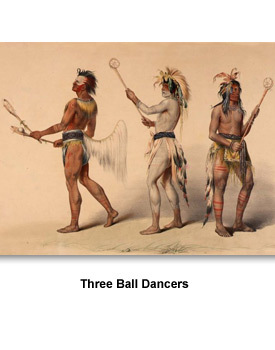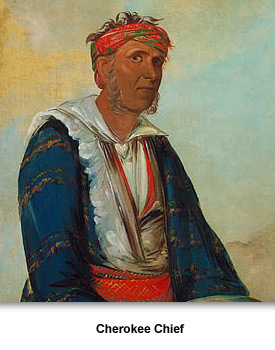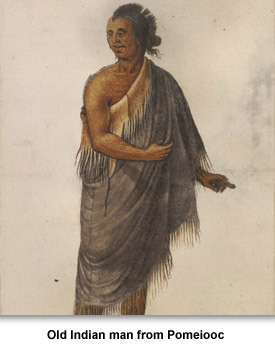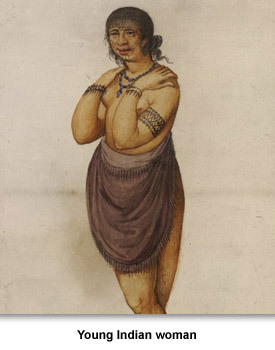Indians & Cultural Encounters
Clothing
Clothing styles were similar among tribes living in Tennessee. Prior to European contact, women wore animal skin dresses. Women used shaggy buffalo hides to wrap themselves in the winter. They nearly always wore their hair tied up, and they bathed daily.
Both women and men wore moccasins made from deer hide. These were commonly decorated with shells.
Men wore deerskin breechcloths and shirts prior to European contact. Thicker hides, such as bear or beaver, were used to make winter clothing. Deerskin boots or leggings protected hunters from thorns.
Warriors wore a crest of hair in the middle of their head with shaven sides, similar to a Mohawk. They also used ceremonial war paint, the design of which indicated clan affiliation.
Once the Chickasaws began to trade with the Europeans, the women began to wear European-style clothing with long skirts made from cloth. Glass beads, obtained from traders, were used for decoration. Men also began to wear European-style shirts, pants, shoes, and coats.
Picture Credits:
- A drawing of a young Indian woman. She is shown with tattoos and wearing a cloth skirt. The inscription above the drawing reads, “One of the wyues [wives] of Wygyno.” This image was originally drawn by John Whyte in 1585 and was included in the book A Briefe and True Report of the New Found Land of Virginia by Thomas Hariot. Later the image was engraved by G. Veen and reprinted in 1590. The woman pictured belongs to the Southern Algonquian group of Indians and are related to the Shawnee. Trustees of the British Museum.
- A drawing of an Old Indian man from Pomeiooc. He is shown wearing a cloth robe. The inscription above the drawing reads, “The aged man in his wynter [winter] garment.” This image was originally drawn by John Whyte in 1585 and was included in the book A Briefe and True Report of the New Found Land of Virginia by Thomas Hariot. Later the image was engraved by Theodor de Bry and reprinted in 1590. The man pictured belongs to the Southern Algonquian group of Indians and are related to the Shawnee. Trustees of the British Museum.
- A hand-colored lithograph of three Ball Dancers, by George Catlin, was done in 1834-1835 while he was traveling in the west. The three men, Choctaw Indians, are adorned in feathers and holding ball sticks. Cherokee play and costume would probably have been similar. Smithsonian American Art Museum
- An oil painting by George Catlin of Col-lee, a Cherokee Band Chief, done in 1834. This painting was done at Fort Gibson, Oklahoma. Soldiers at the fort was involved in the Indian removal from eastern states including Tennessee. Smithsonian American Art Museum
Indians & Cultural Encounters >> Indian Life >> How They Lived >> Clothing




 Sponsored by: National Endowment for the Humanities
Sponsored by: National Endowment for the Humanities